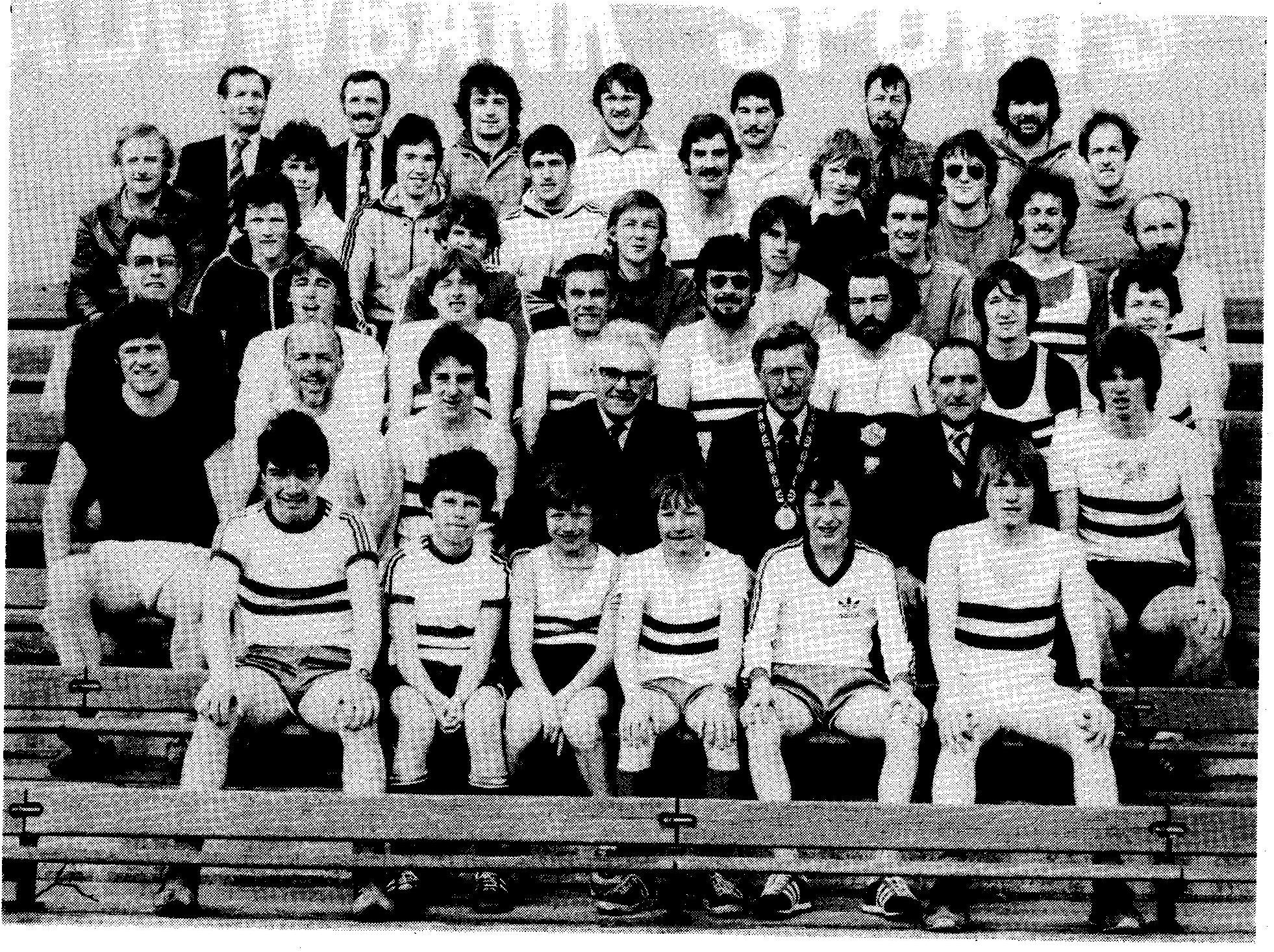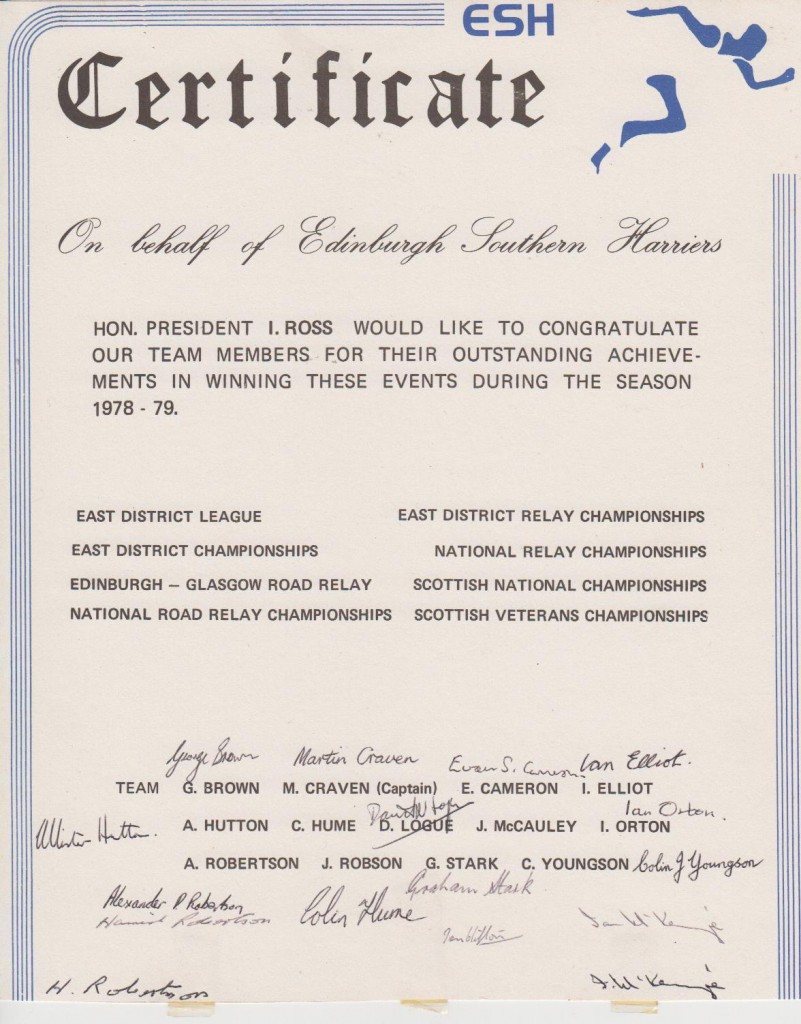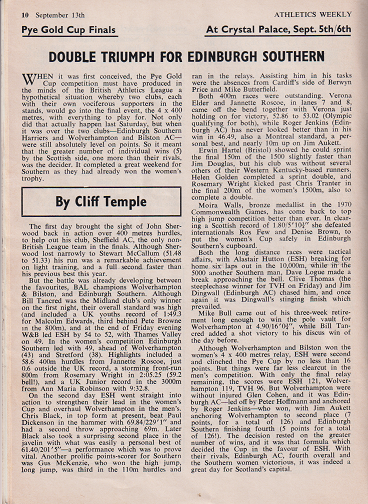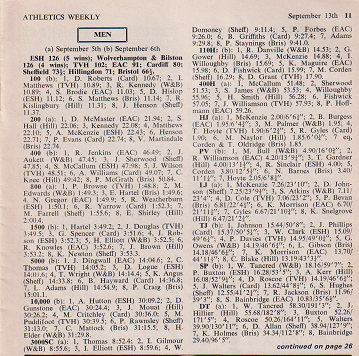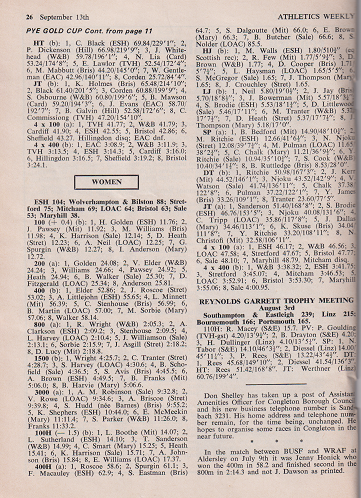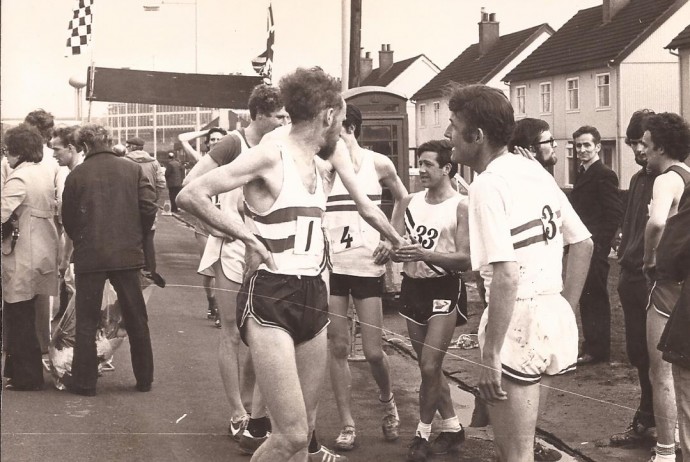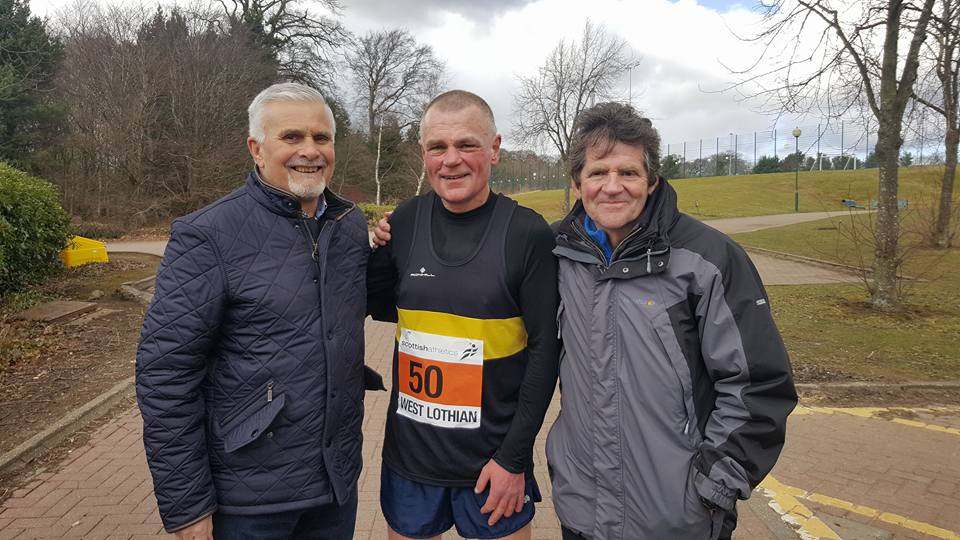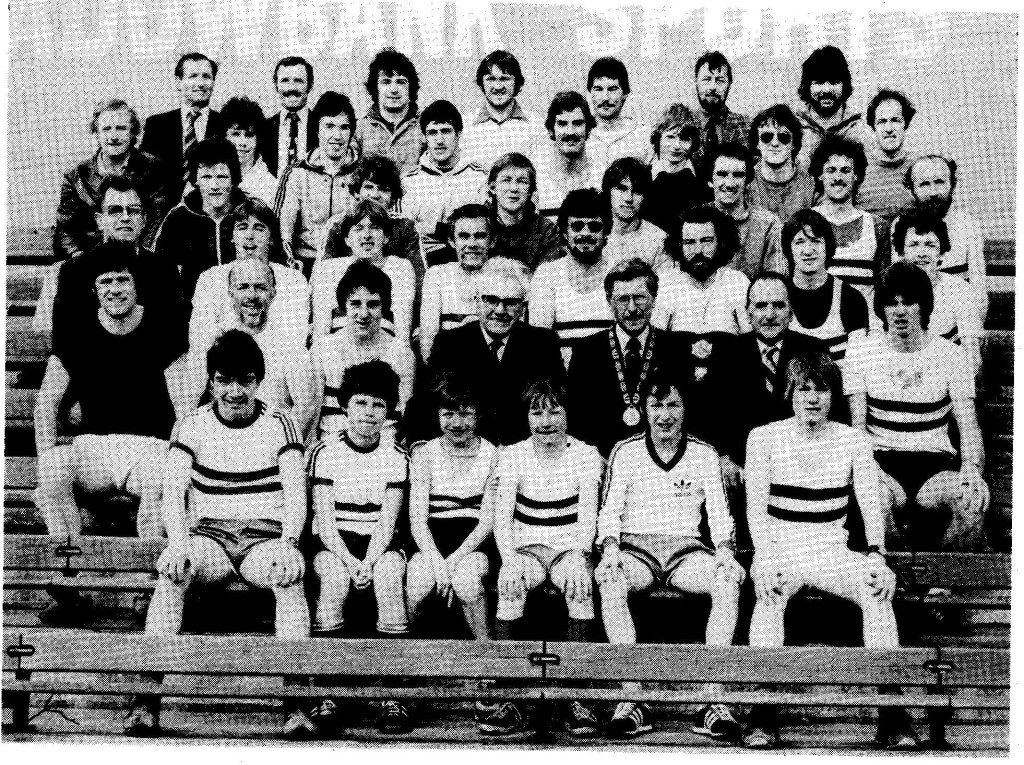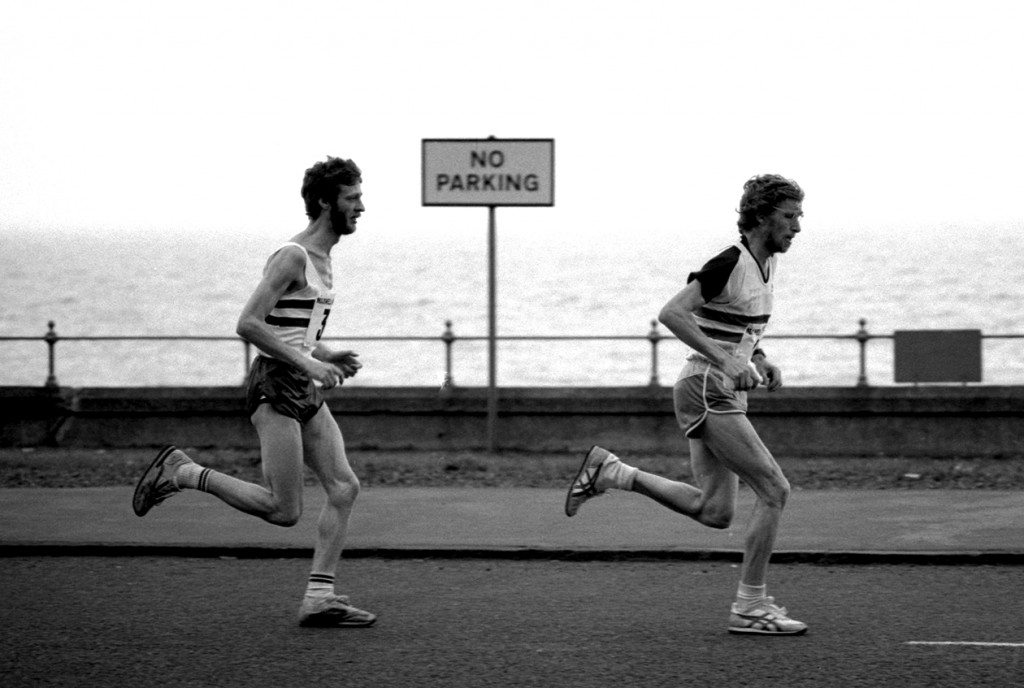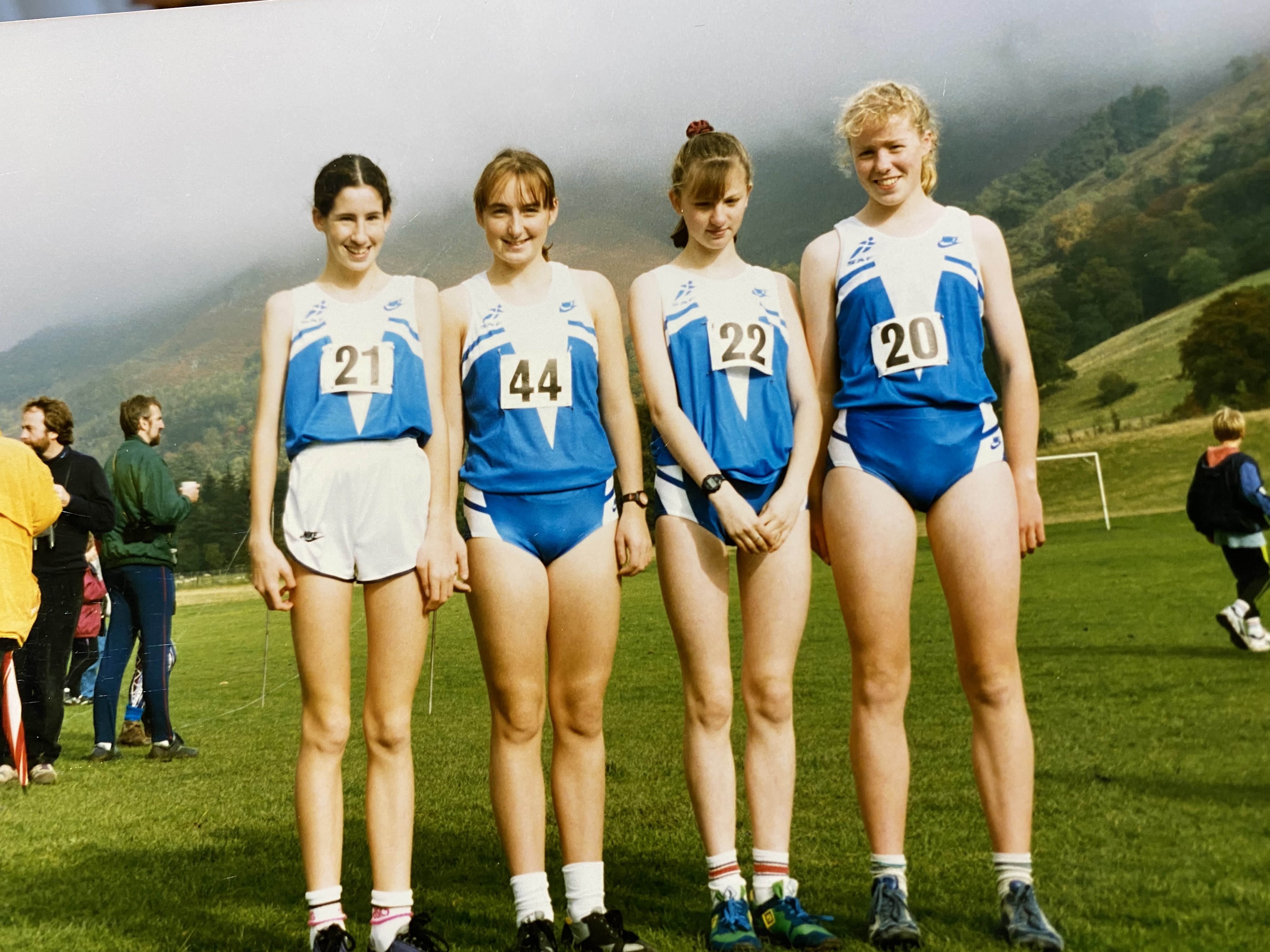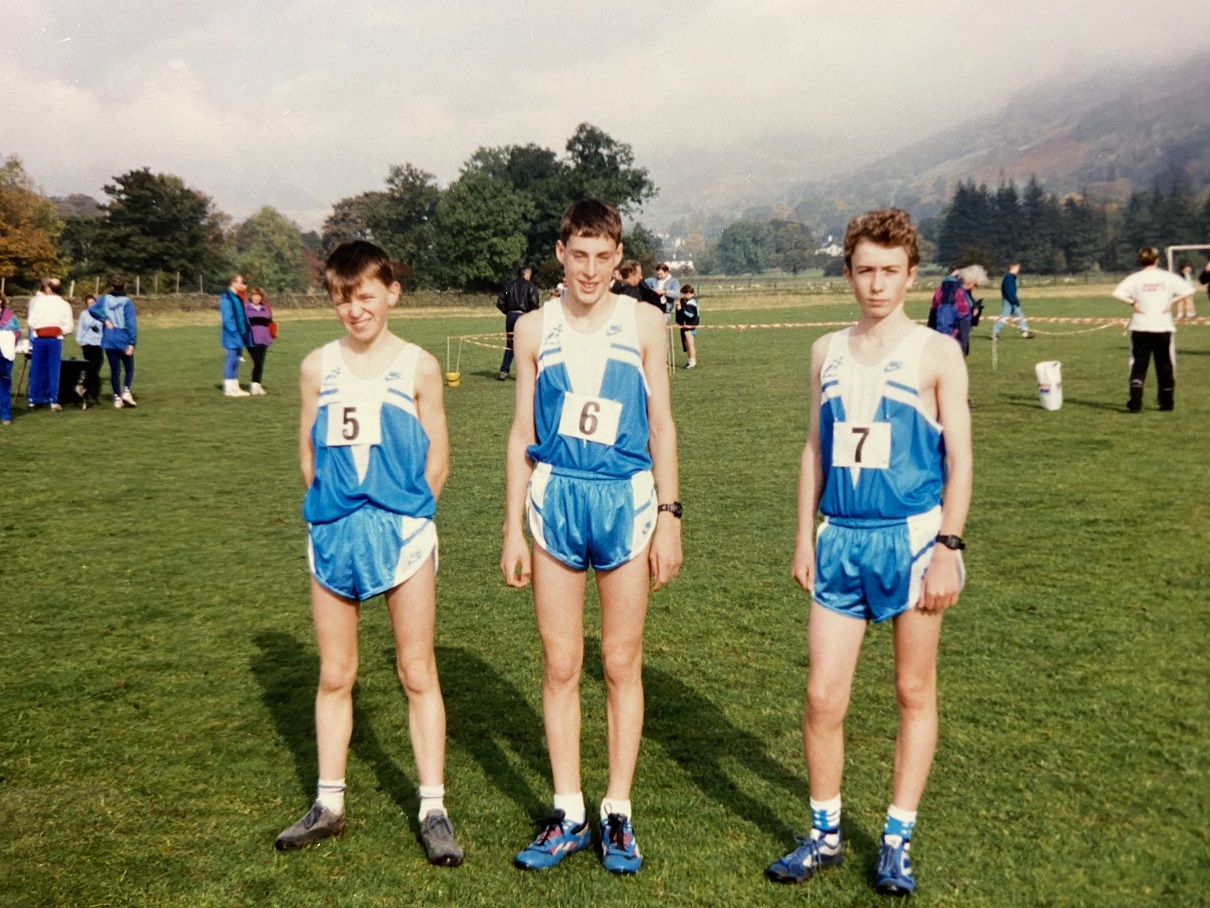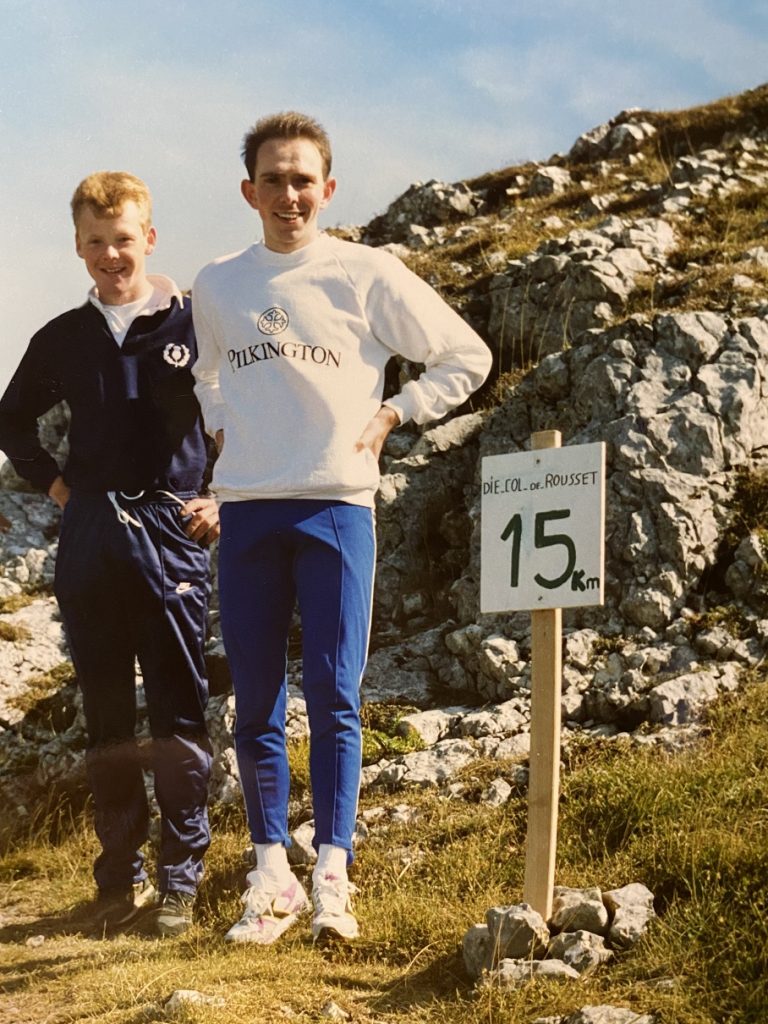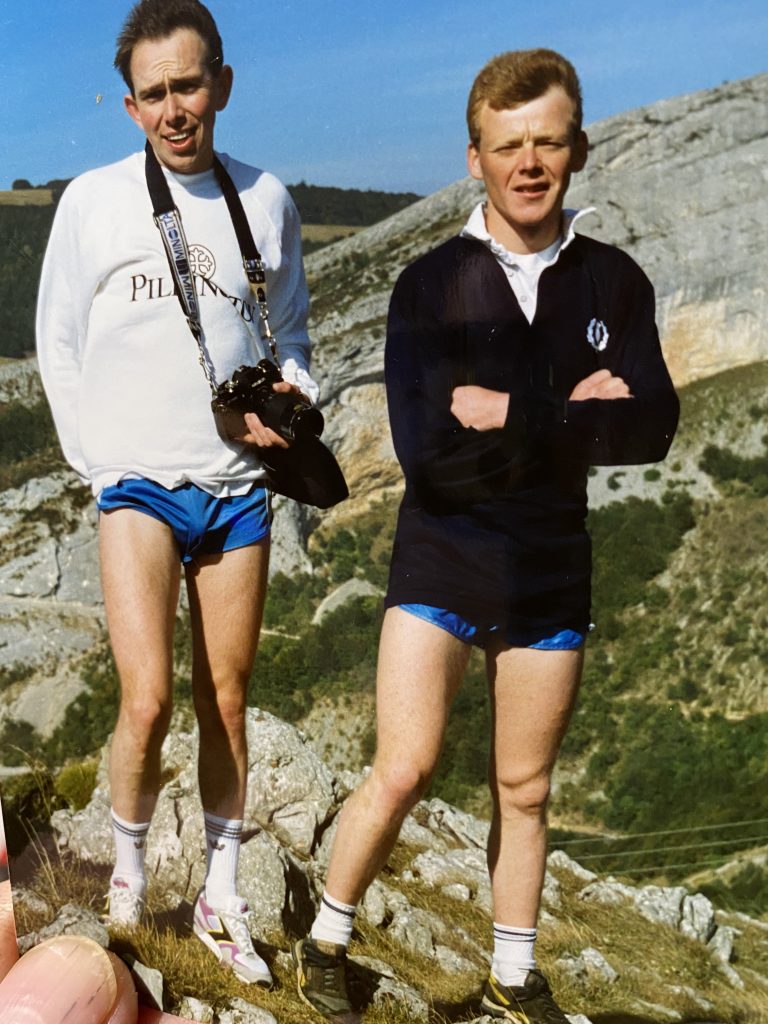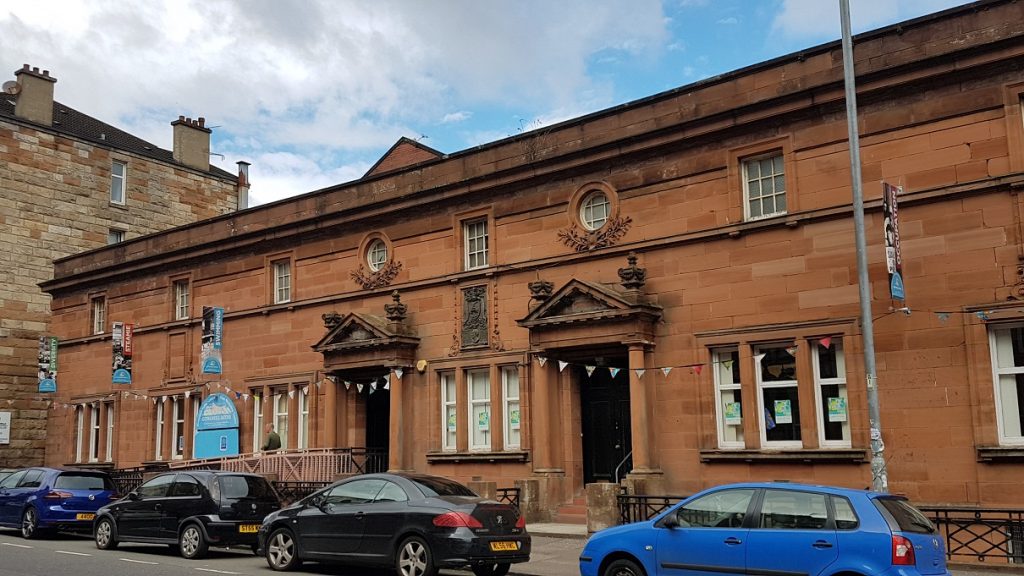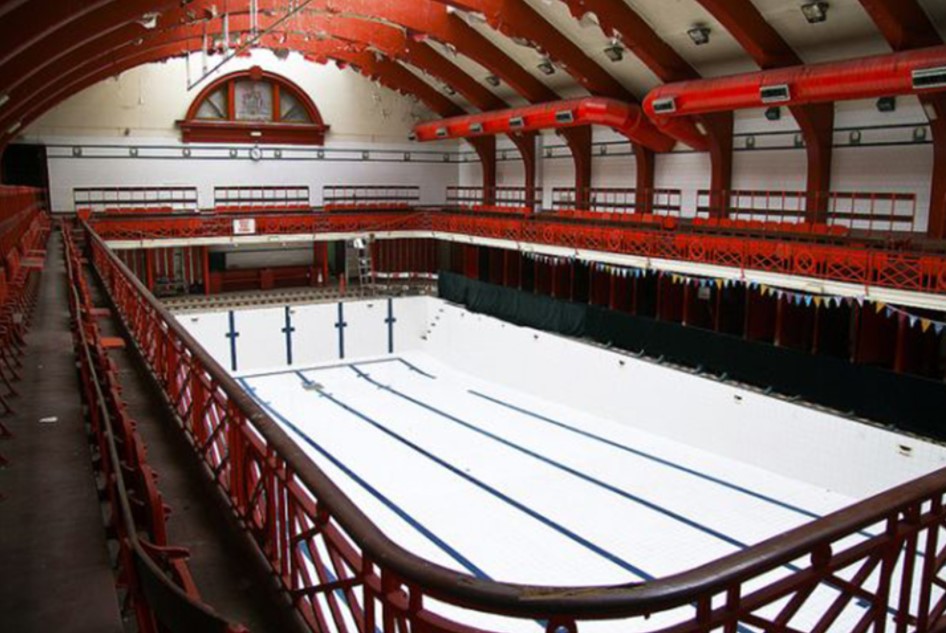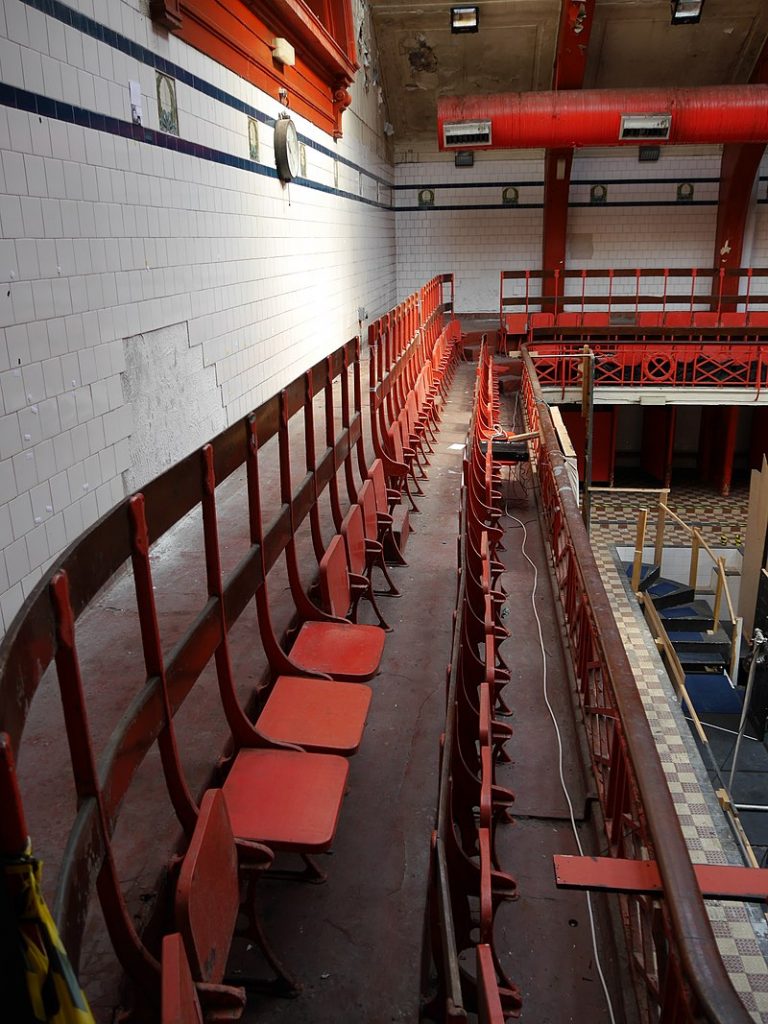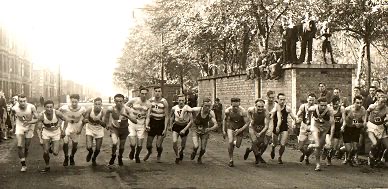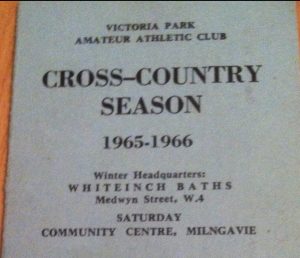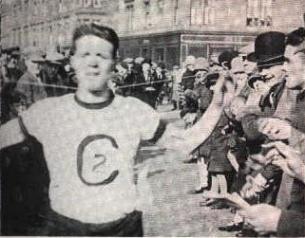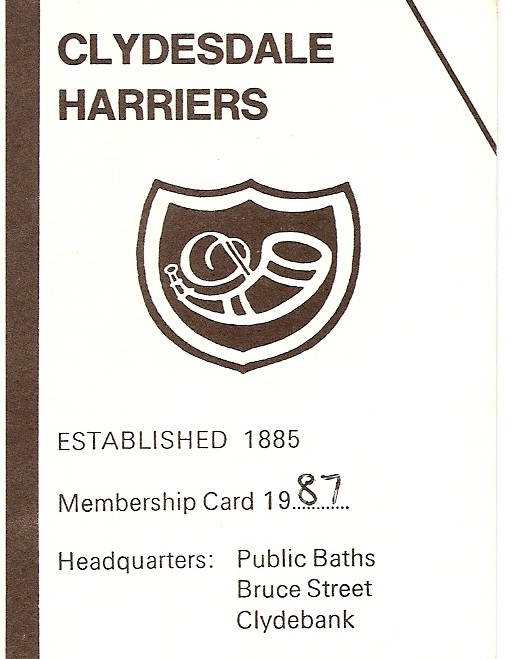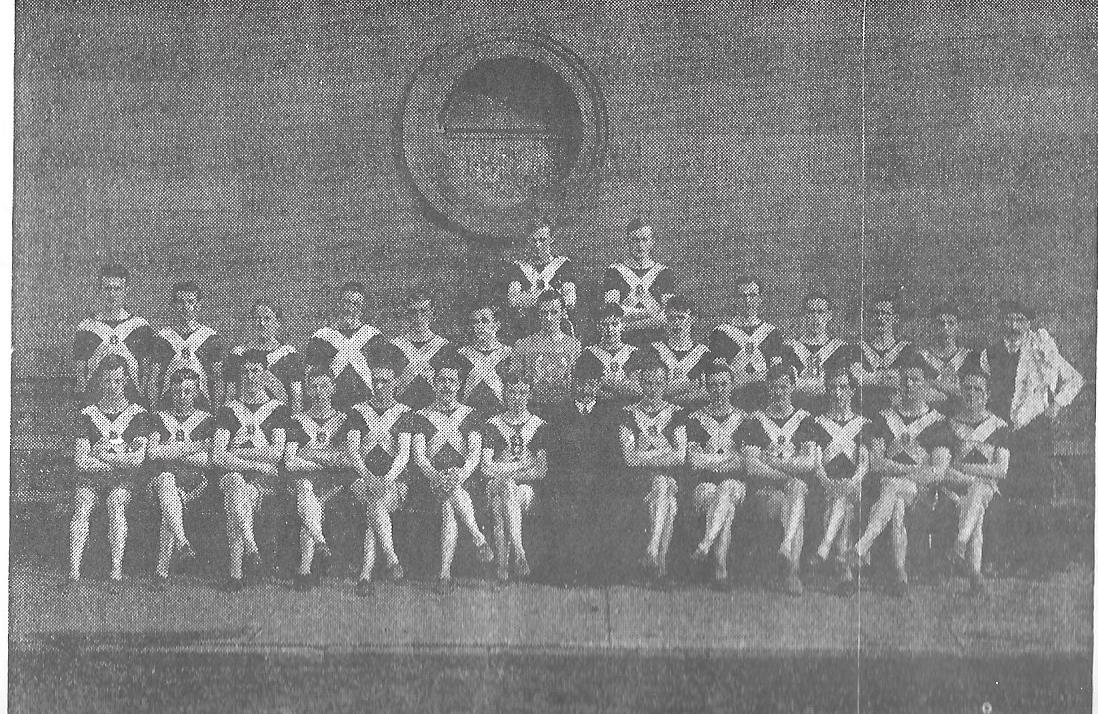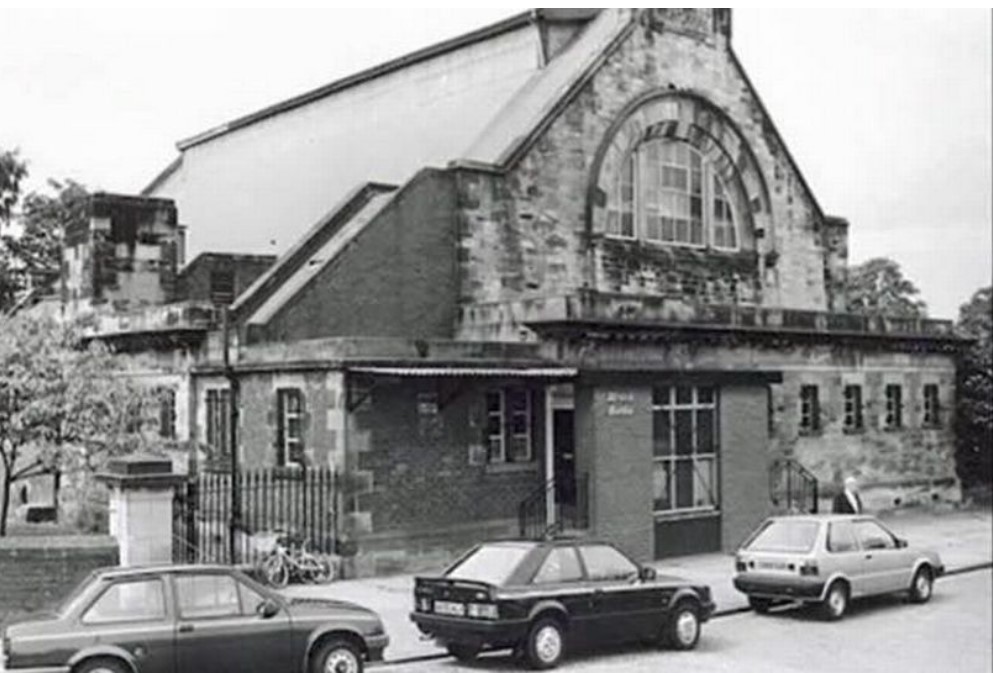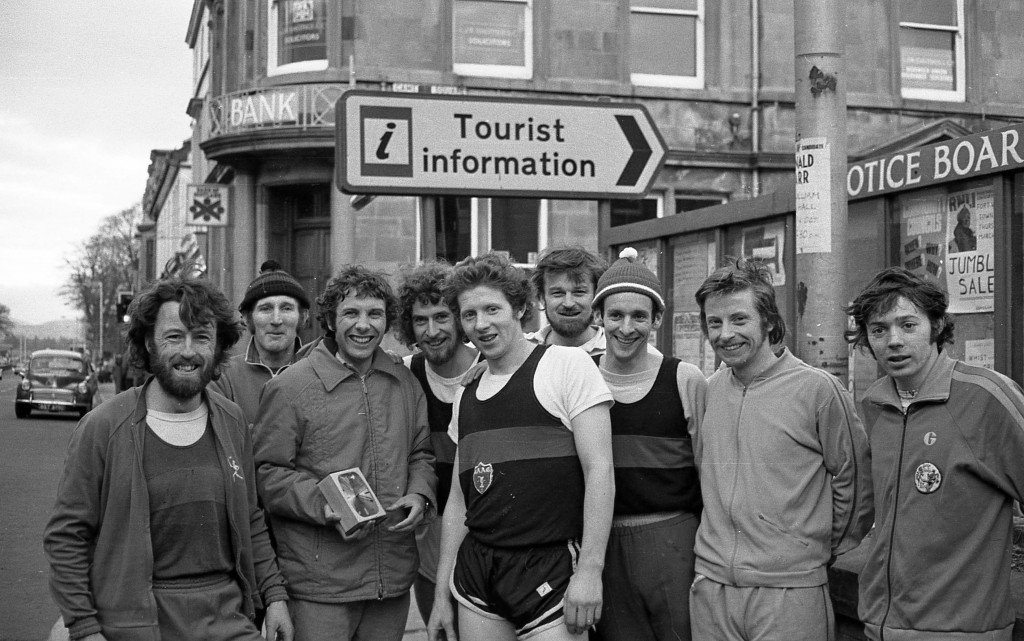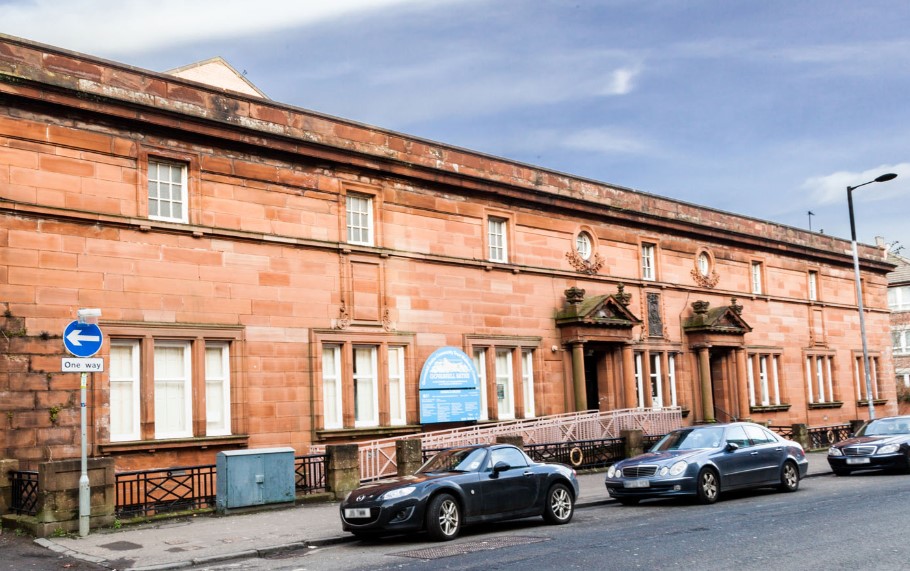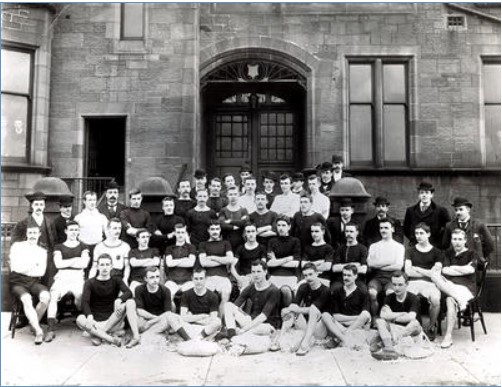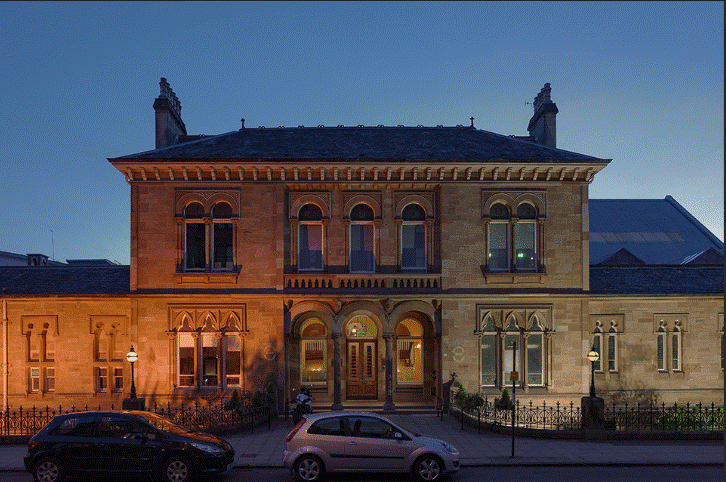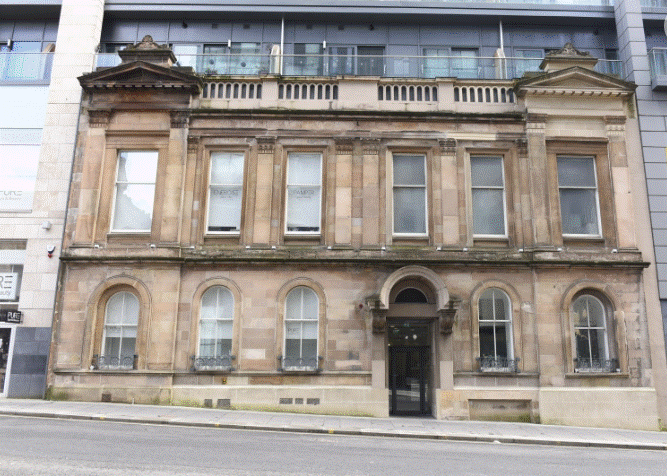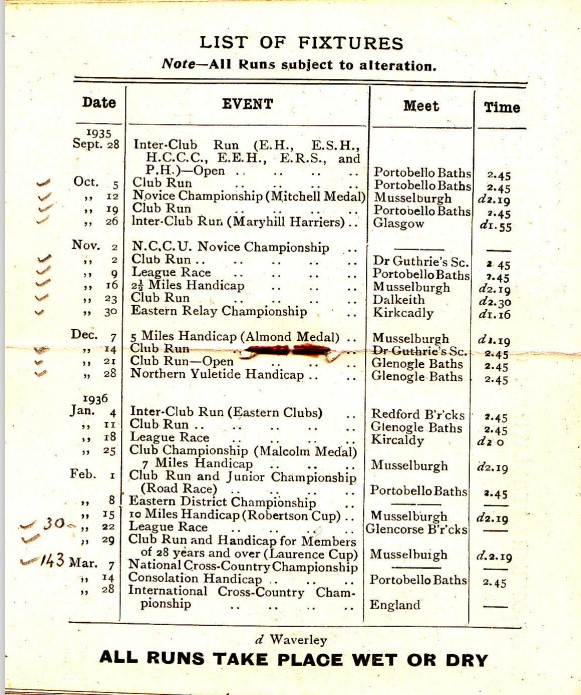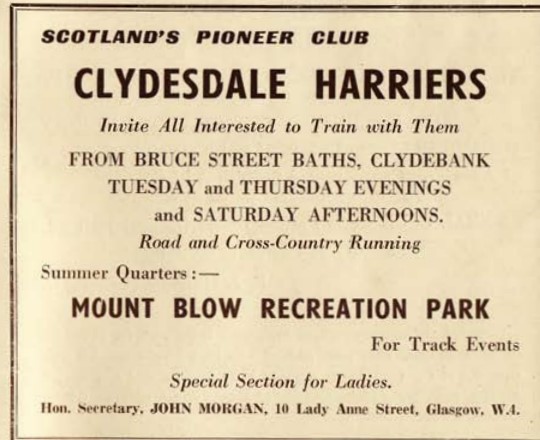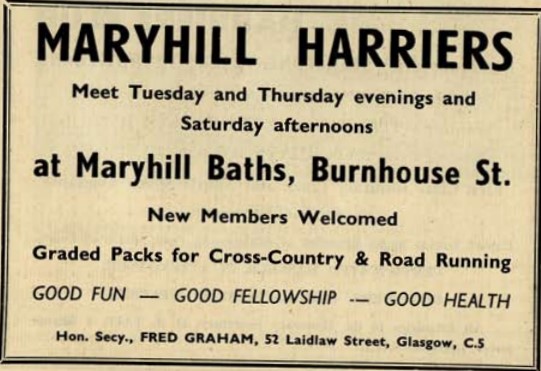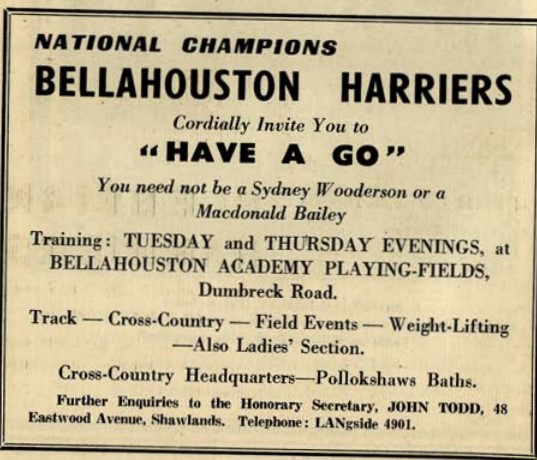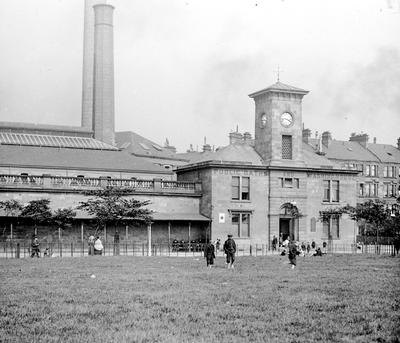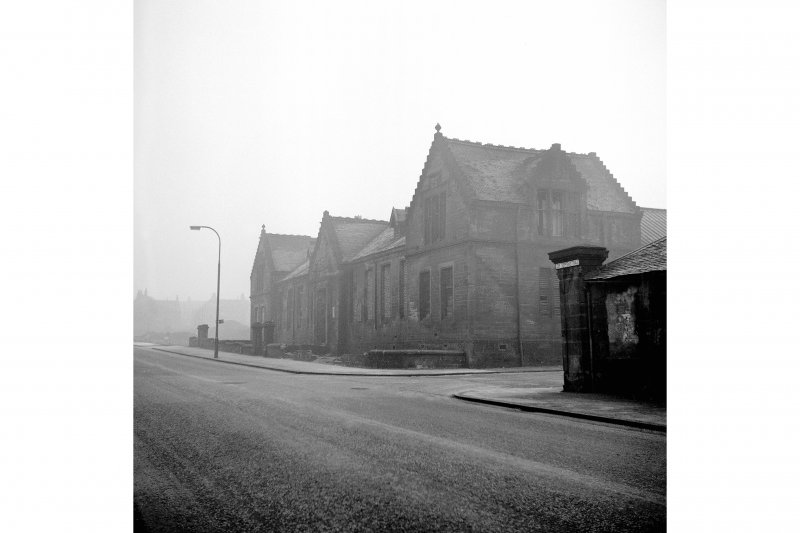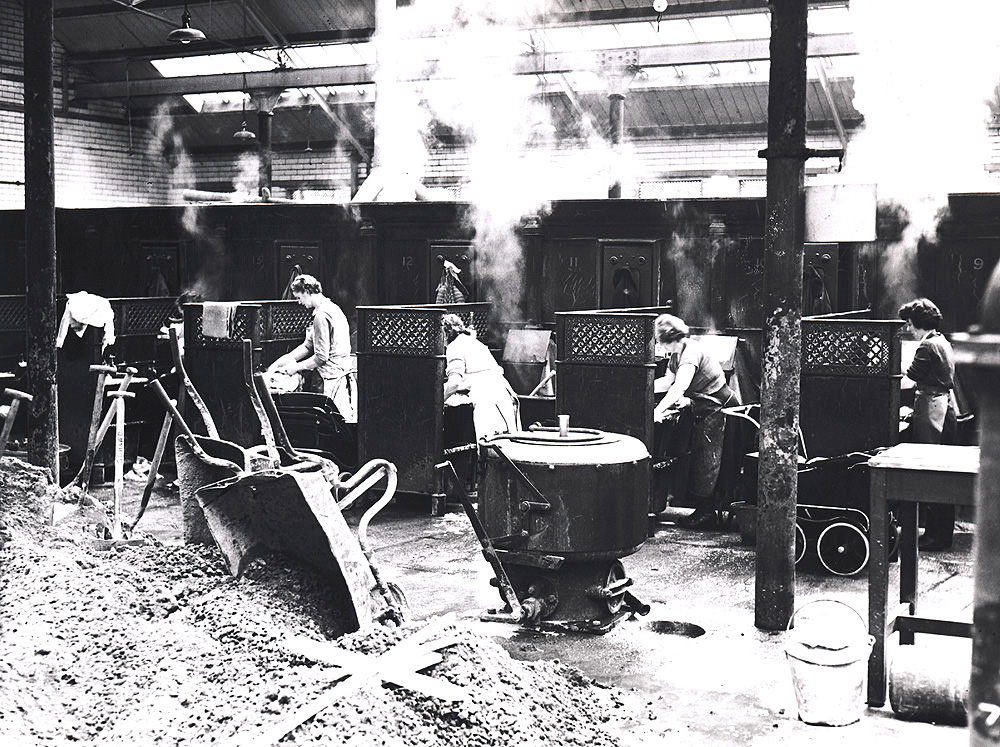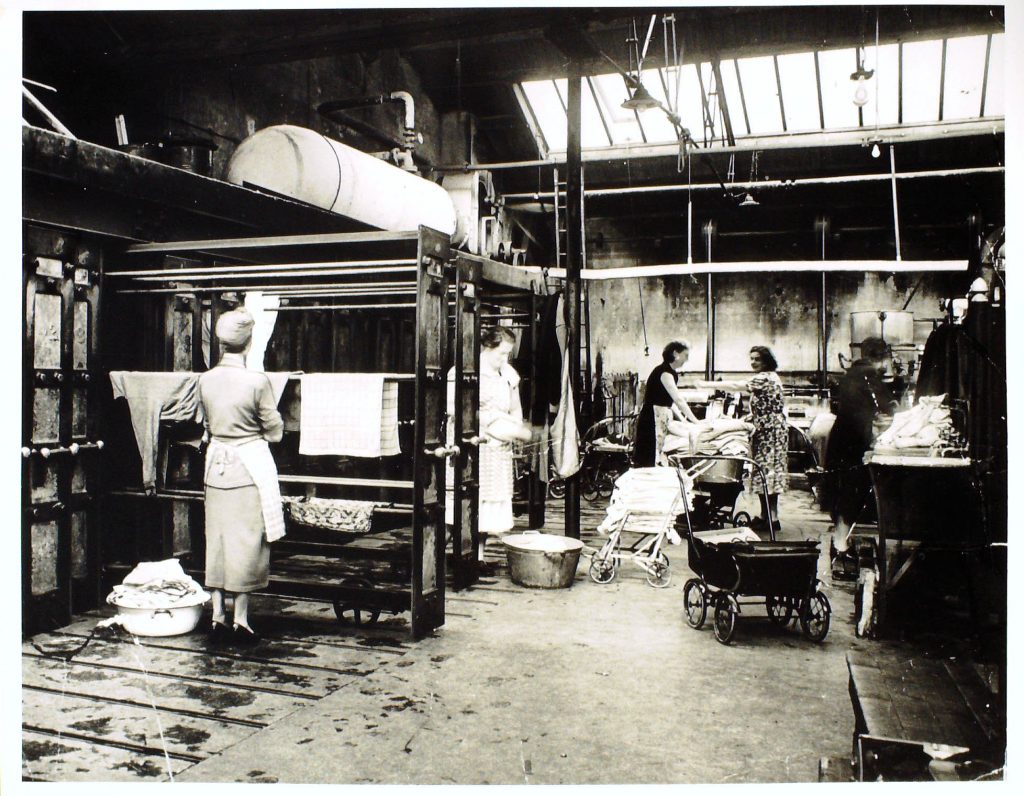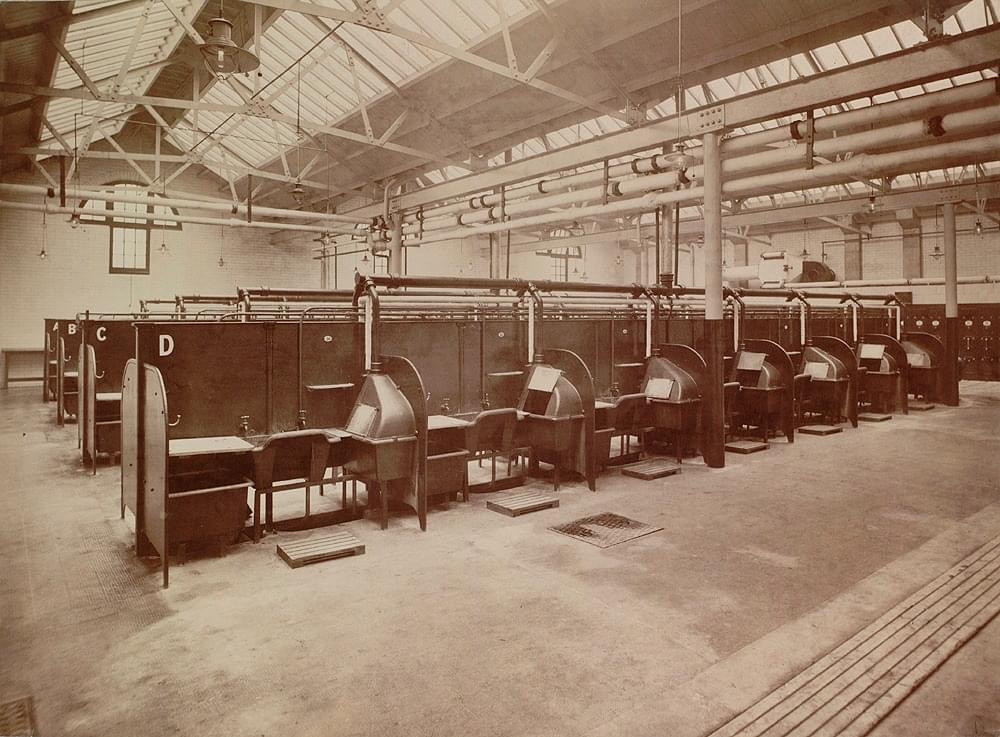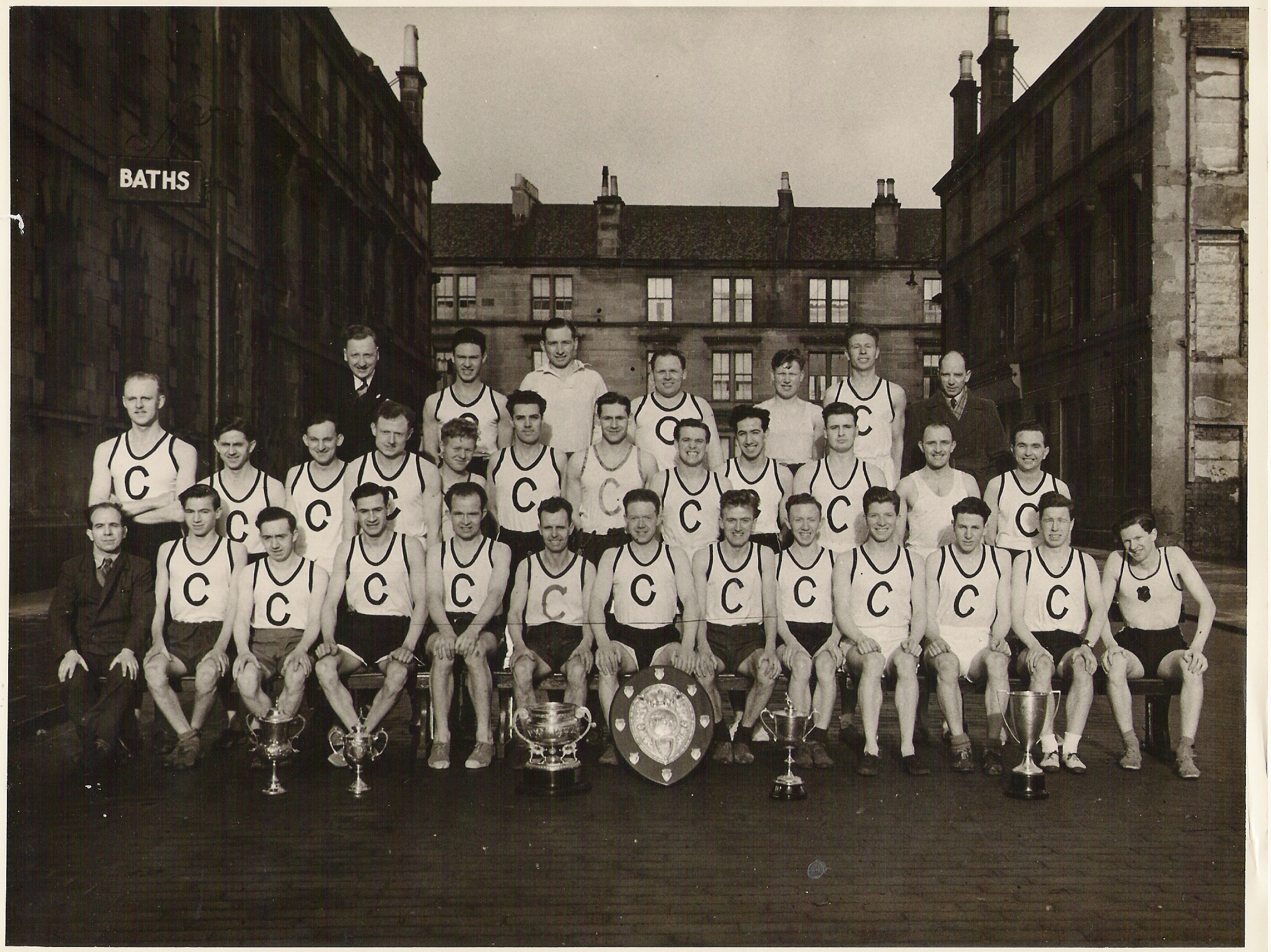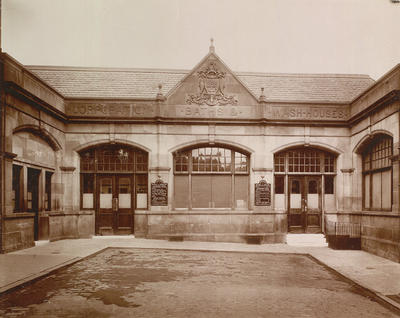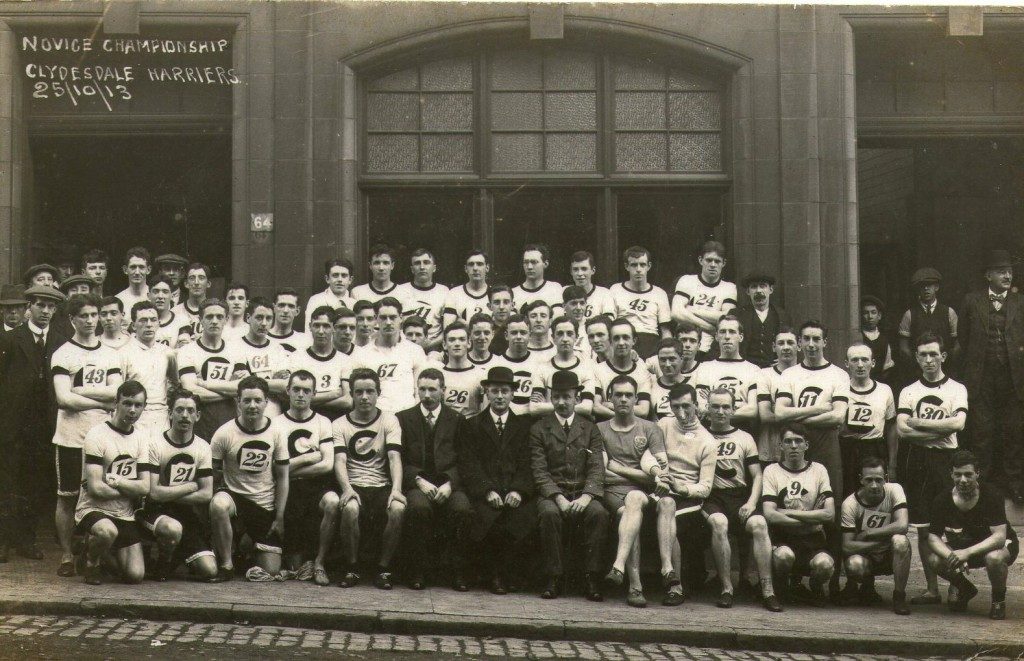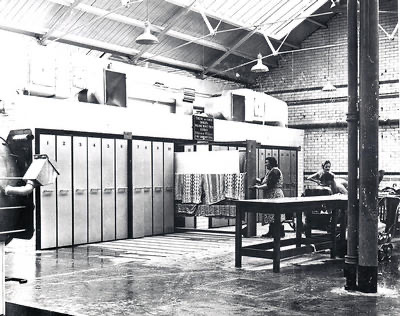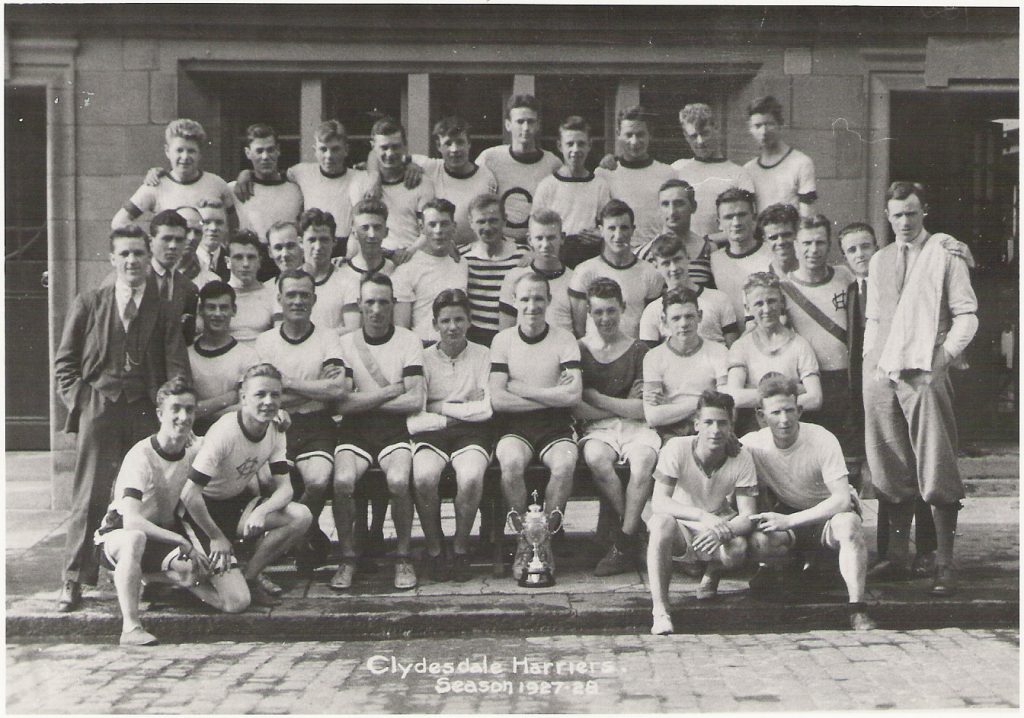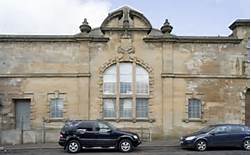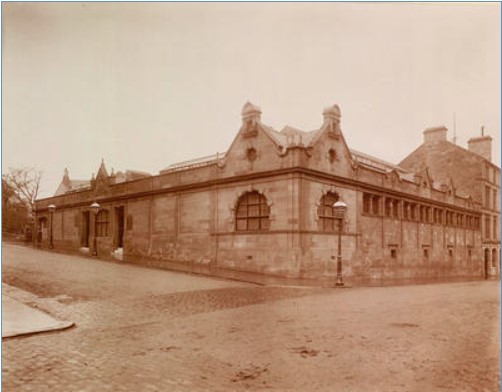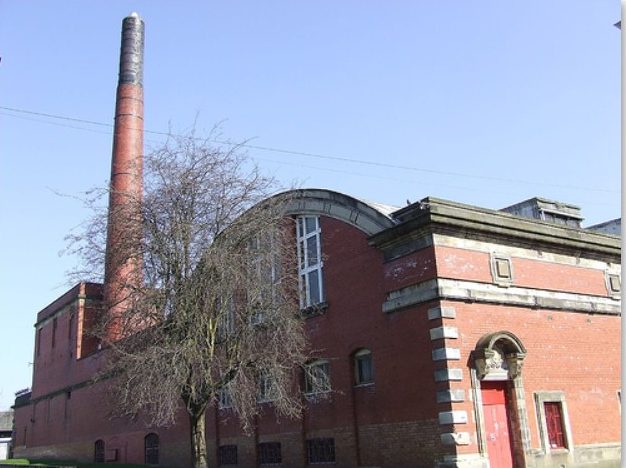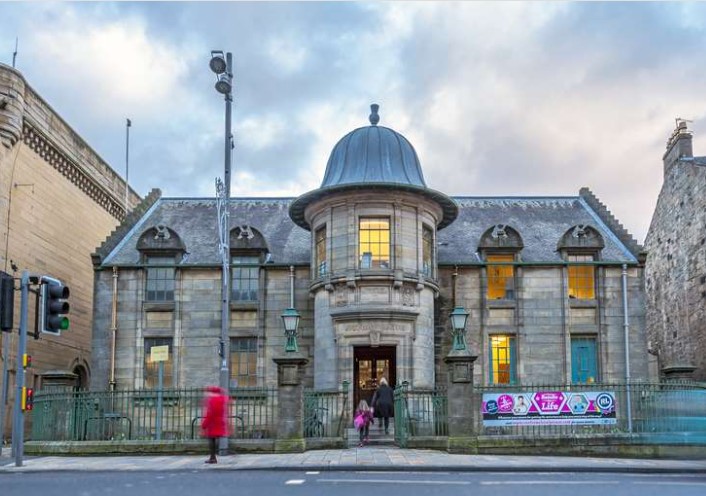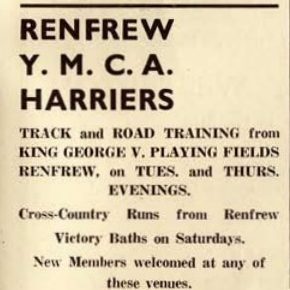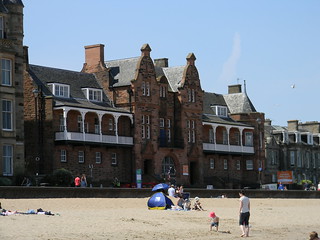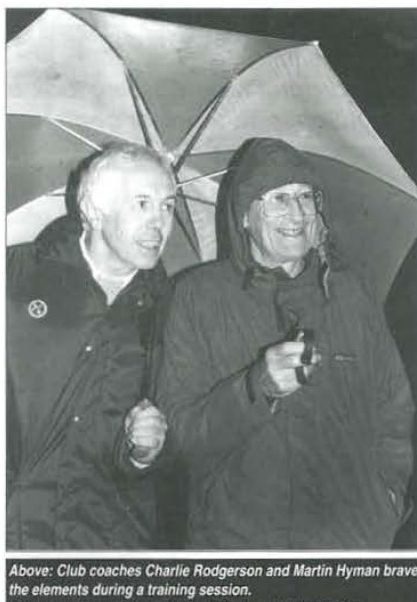
Martin Hyman was a well respected distance runner in Portsmouth for many years before he came to Scotland. Along with his club mate and friend Bruce Tulloh he wrote the AAA’s Instructional Booklet on Long Distance Running which right at the start laid out their intention of getting the best out of a runner with as little time spent training as possible. Remember that this was at the time when Lydiard and Cerutty were doing their coaching and Van Aaaken was working with athletes in Germany. The heresy at the time linked miles run with success achieved: Hyman and Tulloh challenged this viewpoint. Martin also did some pioneering work on altitude training for endurance athletes. He came to Scotland and went about his work quietly, unlike many an Anglo who came north with all trumpets blaring and an expectation of veneration.
This page should be read in conjunction with Squad Weekends and Uphill Only
One of those that Martin met, worked with and impressed was Denis Bell of Haddington ELP and what follows are Denis’s own thoughts on Martin and his effect.
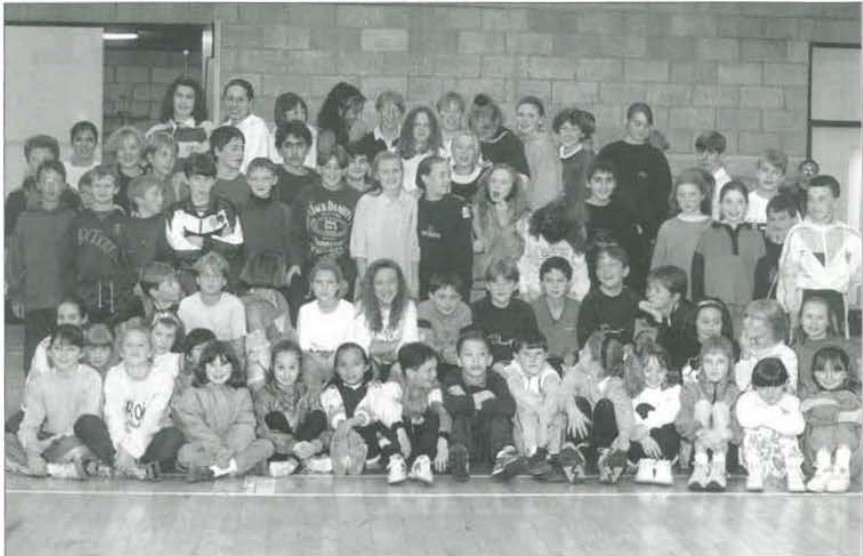
Livingston AAC in the December, 1992, issue of “Scotland’s Runner”
This website is ‘scottishdistancerunninghistory’ so many will know of Martin,….. many might not. Read on and learn something about the Legend who is Martin Hyman of Livingston. Elsewhere many accolades have been conferred upon Martin as a very distinguished Olympian and a competitor amongst great names and with results of distinction, see the Wikipedia article on Martin for a start.
Martin several times mentioned to me (usually over a glass of beer, or a cup of tea and biscuits) that he was not anything like a special athlete with great natural skills and abilities…but he always said that he ‘knew what he could do and would therefore try to “maximise what abilities he did have..’…so the indicator is of a man of self-effacing charm and honesty as well as pragmatism. Martin simply knew that to try and compete with the best he had to do ‘absolutely everything within his own control’ to eke out whatever advantages he could over his fellow competitors. He was very dedicated and very good at that in terms of self-discipline – right training regimes, right prep for races, immaculate researching courses, and knowing his competitors, etc., etc …Martin worked to get the ‘event under his skin’, effectively leaving nothing to chance and just get on with it and run n to his very. very best. Those who know Martin and maybe trained with him (he ran well, well into ‘older age’) will understand these few words about ‘the man’.
What I want to do here in tribute to a real legend is share with you that when he was with us (and I guess Orienteering) the stuff I really know about, his love for and total commitment to hill running. The words I have spoken about Martin’s approach to running was the precursor to his way with us in hill-running and the way he felt about and aspired to how the sport could be managed for the athletes and take on the best internationalists and really compete at World level. Martin knew a good, and potentially great, athlete when we saw one…older runners, prime competing (championship, national calibre and internationalist) runners, male and female, and youngsters, male and female…Martin had time for anyone and everyone who made a very serious and honest commitment to getting better….he asked bluntly and expected honesty…and then if there was true engagement, he‘d do absolutely anything and everything to facilitate peoples’ own aspects of achieving their potential and best successes…
Martin didn’t suffer fools and was sooo very busy and committed, that he had a finger on the pulse and would coerce and health check commitment or, I propose, there was a parting of the ways. It was an unequivocal approach…it worked.
I could and maybe should name names, but fair to say that many athletes from juniors upwards through the heady days of the 90s to the 2000s, our Man, Gentleman, took things forward to new levels and was instrumental amongst a motley crew of many other Worthies, who made very significant and real differences to the way hill running grew, matured and evolved at the ‘international level’. It was very much about how the best can be better; how the young and emerging can grow and perform, how to be ‘winners’. In saying this he did a huge amount at grass roots too, and was highly respected from being amongst the ordinary and good of hill running. He managed training weekends (see some attachments of real events), he managed juniors at Livingston Athletic Club, he set up races ([orienteering ]..cross country, hill and international selection events, and actual courses, etc.), and of course he set up and managed personally ‘the Meadows sessions’ which quickly became legendary holding this commitment for about 30 years. Others have stepped into the breach in more recent years and these sessions remain as an ultimate, very worthy legacy to Martin; these actually are the hallmark of what supreme involvement, and stewardship, and detailed commitment, and steadfast management our Man carried and of course, in return he was held in colossal respect by all whom he met.
Was Martin a ‘saint’ (that might be a totally inept word?!) …no!…but simply a man and gentleman held in the utmost respect. You could ‘cross’ Martin (I did a couple of times) but there was no animosity, there was only a difference of opinion and approach and without any anger or angst, we simply moved on and got on with things. Martin could and would accede…but he’d never ‘change’, and this again was a sure-fire indicator of his passion for ‘right and proper’ and his way was right…inevitably of course he was most certainly right; we had arguments and discussions but we could temper and approach …so ‘compromise’ was there and things worked, very well.
I will share an abundance of stunningly good examples of what Martin gave us in hill running…and you’ll see it was ‘life and soul’ and the sport is the much better for it, and the way he coached and mentored athletes, and also admin people and hill race organisers, and officials and the upper echelons of Sports Administrators was simply exemplary. I might be considered to be waxing lyrical, but that’s fine…no-one can deny me my knowledge and experiences wide and many, over many years, of our truly Great Man, Gentleman.
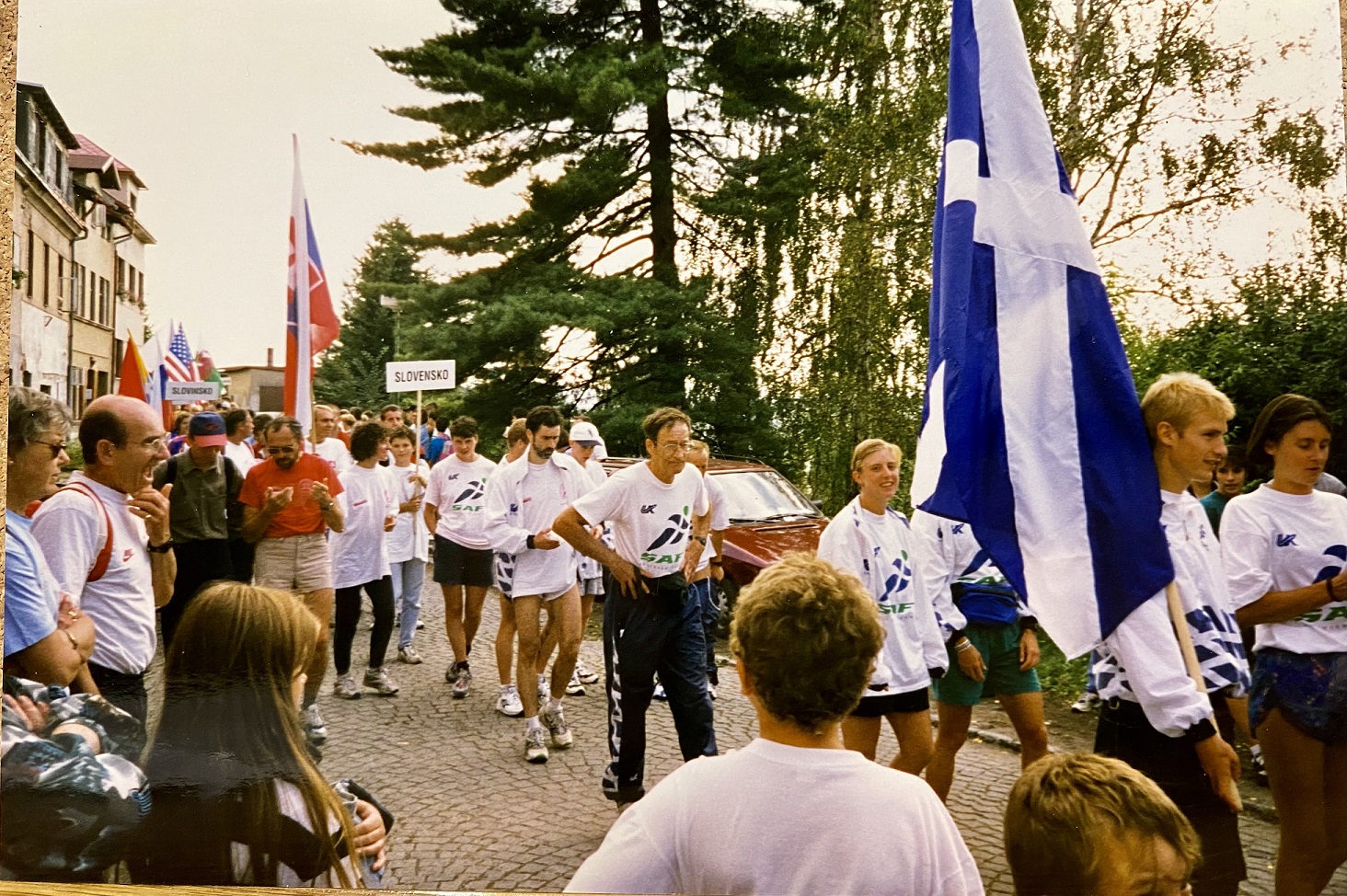
In the centre of the picture – one of the team.
I wrote these following words, and not so terribly long after Martin left us with his terminal illness… Martin leaves Margaret his very dear wife, and their sons, the boys, the grown fine men. Fred (Michael) and Pakit (Patrick), and in-laws and grand children.
A very early recall is one of a meeting in a Glasgow Flat (with Helene Diamantides and Mark Rigby [two utterly brilliant athletes] and others I cannot recall immediately, where we were discussing the way forward for hill running, grass roots(??) and towards international honours (the cream of athletes)….{any readers who can add things here should please contact me for fullness}. Well in short, I do recall that I differed with Martin’s ideas somewhat. I think that his was a very much ‘elite athletes’ take and mine was probably more to do with the ‘grass roots of the sport and development for all’..no matters…what I definitely recall was this was ‘a powerful man of principles who was direct, honest and very pragmatic’. This was surely for me the very first step of a truly wonderful relationship with a man I could easily associate with, and we were moving forward together, with a fair number of other very good hill runners who’d take our sport forward. This might have been an early informal meeting (or as was then ‘committee’) about Scottish Hill Runners Association [SHRA] moving towards the Hill Running Commission [HRC] to be integrated as part of Scottish Athletics [SA]. A key here might well have been towards formalising a way to achieve at international level by accessing secure funding..when the previous way was a ‘good-will grant of some support financially’ …anyway it was not all roses…the period of change upset some of the purist hill runners (who had a slight disdain of the ‘blue blazer brigade’) whilst the committee knew that to support internationalists (grass roots racers sometimes’ don’t care about the elites.. Fair enough!) we had to get a more formalised method of accessing funding.
It was the start of a very good strong relationship and it went form strength to strength as Martin helped shape a new approach into a very bright and dynamic future of the sport.. Martin already had a legacy on the Meadows sessions, orienteering and at Livingston. He was always, always very active – committing to and doing loads of initiatives. Buying into personal needs, juniors, and all across the full spectrum of the sport. Everything involved in, came up with good results and often outstanding.
He was also a colossal administrator – planning, schedules, to-do worklists, venue arrangements (access rights), mapping, gathering boxes and boxes of tools, aids and provisions, buying-in ‘The Team’ who’d make happen (all to the clearly detailed plan of detailed requirements). It was a case of… if you honestly ‘Commit’ you are ’IN’ ..simple…and get in there do what you said you would and make things happen. Simple and effective, repeatedly year after year.
So to some timeline memories (and please check the various schedules Martin issued to us all at the various planned events). {Photos of Martin’s outputs to be placed in whenever it thought best to interrupt the text} I’m certain Martin told me that the Meadows have been running continuously for 30+years, of course the great majority ‘religiously’ by him, then ‘others’ have taken on the mantle faithfully and do them to this day.
I personally never did any, but I recall a great friend and co-runner of mine Peter Marshall (another H.E.L.P. stalwart of great repute) used to travel form Cockburnspath to participate in the hour sessions. (Peter was a super hill runner and was one of few in HELP who did ‘all manner of events, and was an outstanding vet champion..). Note please Martin = consistency, continuity, commitment, enthuser and inspiration.
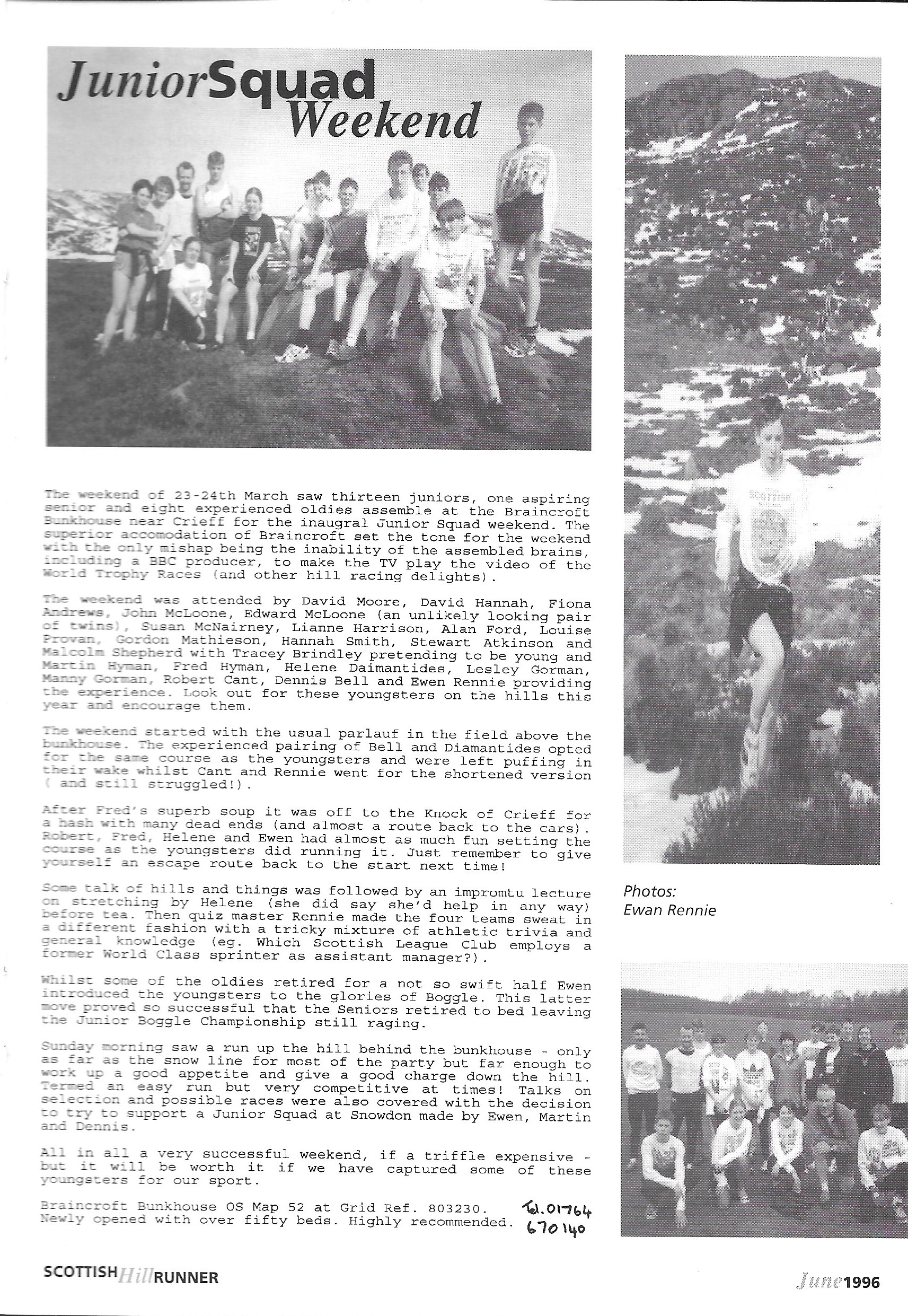
I recall the concept of squad and Martin and I planned a weekend of ‘team bonding’ a few weeks before a World Cup (Jules Rimet guys didn’t like that [copyright?] so it was re-named World Mountain Running Trophy) up to Glenshee Hotel…a bit of a ‘first’ I think and it wasn’t bad, but not really hill-runner squad style…. We took feedback from the 14-16 athletes who took the chance; Martin felt it wasn’t really value for money and just not right …. he WAS right! We changed.
I recall an initiative to go up to Glen Doll to recce the (original) Angus Munros course (an Edinburgh -Livi sortie by a dozen or so of us ..) ..It was a grand experience…I was not that long-hill-race savvy, and I probably didn’t have the confidence to do those long unmarked off-track routes, in wild open countryside, in poor conditions using map and compass…the weather was good so we could see, easily pick the tops, and followed the route no problem which meant we could ‘pick best lines’ rather than go ‘direct on the compass….great hours out. So simply ‘agreement to gather, car-sharing, light organisation and we did it under Martin’s initiative….(remember … leave nothing to chance ..if you have no experience, invest and get some!). Martin’s way …Planning and Preparation! It worked for me because I placed very well, still as a newbie (long distance) hill runner.
(Jock’s road, Tomdhu? Sinclair Hut? Broad Cairn? Cairn Broadlands? …..back to Broad Cairn and off..?? anyway it was something like that 40 years ago nearly.
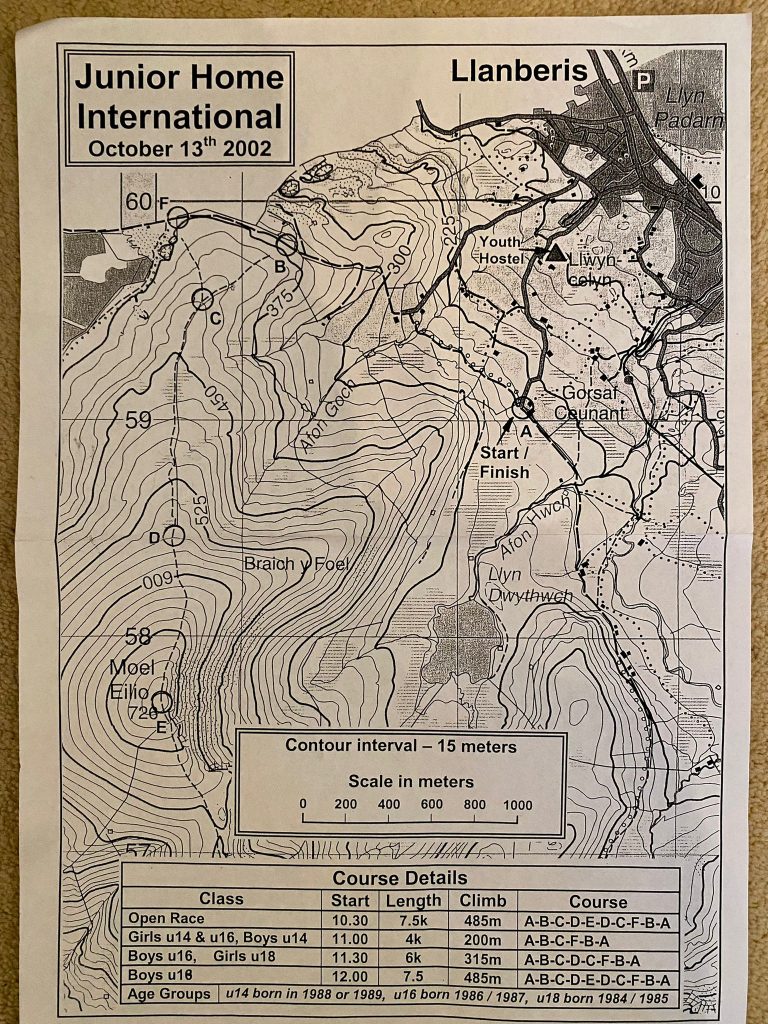
As we got better organised as a ‘sports body’ largely don to some super efforts by committed athletes (racing hard and managing well) the structure to tackle uphill races and also to provide a platform for honing skills, the ‘Squad Training Weekends’(STWs) started to develop as well as uphill only races. Martin was pivotal in most STWs and led most of them though very wisely co-opted others in the wider-flung regions away from the Central Belt to also take ownership (Dougie Milligan, Dumfries; John Hepburn Lochaber; Ewen Rennie, North East..etc.).
We had 1 or 2 STWs most years and though they were joint events initially with juniors and seniors we again pretty quickly realised that they didn’t work best and they separated successfully. Along with slightly different organising teams for each ‘age category’, Martin was very much a presence at nearly all of them…Venues were Wanlockhead (first ever, fantastic, and so often repeated thereafter).. Dalbeattie, Glencoe, Scout Centre Lochearnhead, Scout Centre (Fairmilehead) Edinburgh, Fife, North East, Borders, Inverness, ….
So the formats stuck (fewer events for Juniors) and Martin’s planning and preparation covered the Weekend Agenda, time-lined over various activities; some seminar type, organised runs, free running periods and obligatory socialising…! The format was simply to encourage ‘anyone’s improvement potential’ and by rubbing shoulders live and learn – whilst originally planned for taking ‘Internationalists’ up a level it actually seemed to serve ‘ordinary racing athletes’ the best and got most commitment from them ..elitists have their own approaches normally and in this respect ..the ‘aspiration towards the elite’ actually failed to a degree…but was hugely successful in pulling up ordinary runners to great runners, and helping encourage youngsters to stick with it to aspire towards young seniors of real potential…so ‘it WORKED’, very successfully, dialling in parents as assistants and coaches, etc.! I recall events for the likes of 20-50 people and it’s important to mention the format was very ‘low-key, basic’ decently warm and dry ‘lodgings’, and good wholesome food and drinks. Martin effectively did all the shopping and we never ever went short; the surpluses at the end were shared and a small contribution made for them [I’d be certain Martin always subsidised these events, generously, to a fault and never ever mentioning anything about it!!]
So Martin did all the planning and prep (unless a delegate in the region booked the event meeting place), all the paperwork (sign in form etc., and safety sheets for the scattering of people into ‘often unknown areas’), maps, schedules, results sheets, crib-note sheets, organising the team of assistants , car-sharing arrangements to get non-drivers and the youngsters to events, and helping facilitate, time and manage the sessions..(relays, personal timed circuits , mapped legs etc.). I assisted and I have done stuff like this… it is a huge and committing effort, and Martin did this par excellence; these weekends really truly worked, year after year, EVERY time.
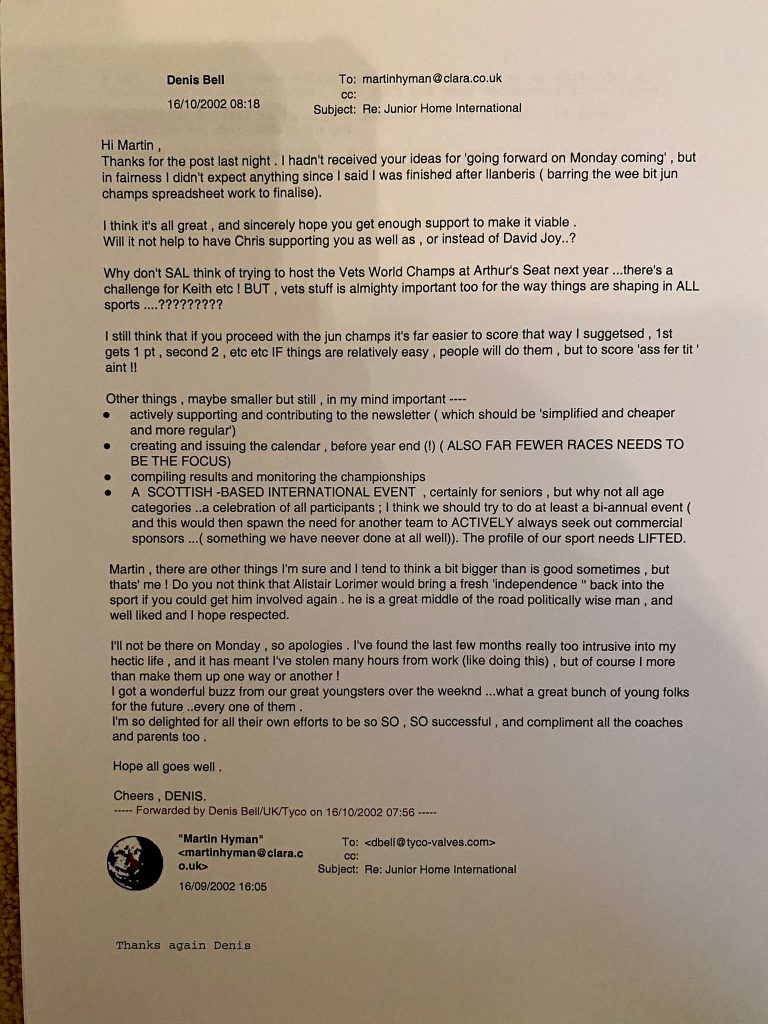
Whilst a general top manager for the whole scope of SHR (SAL, HRC, etc) Martin also focused on Livingston AC (LAC) and engendered great enthusiasm and purpose and for certain engaged parents and adults who equally gave such a great deal to the club and made it very successful on many counts (I do not know the specifics so please look elsewhere..). One thing is for certain: the club has had brilliant athletes in all manner of athletics events. Many of us will be very aware of the prominence of the bright yellow vests with green vertical band on left side. There were so many but how about these for a start –
* Andy Kitchin, * Joyce Salvona, * Ann Curtis, * Andy Curtis, * G Ackland, * Jonathan Musgrave, * Graham Bee, * Ian Donnan,
I think Martin always revelled in the youngsters getting engaged in ‘sport’ and encouraged parents and parent-coaches, and took on several youngsters in person to coach to truly excellent levels. “A really, really nice bunch of kids’” would be the words Martin enthused on his aspiring young team, a team spanning 20+ years, boys and girls who came from ‘nothing’ or humble but emerging beginnings. His utter joy and satisfaction was to see, to assist guide youngsters towards superb results and fulfilling some of their potential (at times youngsters from ‘challenged backgrounds’ made it even more special {would it not have been utterly wonderful to have had a teacher of Martin’s dedication and experience and care?}
It occurs to me the Margaret and Martin (with total commitment to sons Patrick (‘Pakit’) and Michael(‘Fred’)) always ‘funded’ youngsters for very many years, helping ease and encourage their ways forward…..(Margaret ..names track and field?); road and hill running, orienteering, etc…Martin was well dialled in to all aspects of personal development and would truly support any and everyone who showed genuine commitment; stars, current or emerging were one thing, but anyone at all, anyone who was serious about improving got the ear, the wee bits of advice and guidance they needed, always. He clearly got that a lot of good and even great seniors had ‘learned what mattered’ and had their own routines (but he was always a very attentive listener and would proffer comments or advice when sought). For youngsters and raw senior newcomers, he was especially supportive and would seriously and personally help steer those folks forward….I cannot evaluate that in number terms but would not have been surprised if it wasn’t 5, 10, 20 people at times over the spectrum of ages and capabilities.
As an ‘organiser-extraordinaire’ we just need to look at the meticulous detail and quality of communications with everyone engaged in the various events …see the pictures of records following. astounding…quality, quantity, clarity, user-friendliness, template formats, instructions, tasks and assignment sheets; advice on where to be, when and and and…superb!
Looking back now, of course the canny management meant keeping in touch and the spreadsheets of contact details would be a real burden by current IDPR demands (security and authority on personal record details)!! I guess that martin would rail against the lack of trust and integrity by such an additional burden but nonetheless he’d understand and comply. In all the events we undertook I really cannot think of any ‘misdemeanours’ or conflicts of interest and personal care. There always appeared to me to be respect for Martin and the seniors who helped make these wide array of events possible and such successes. It is relatively such a long time since I was involved in those events that I cannot properly remember the ‘make happen’ leaders and teams but again such was the respect for Martin that he could always call on the hard core (20 individuals?) who faithfully pitched in , leading, assisting, doing all manner of wee side actions to help , enabling and often critically important car-sharing, and getting non-drivers, or juniors to and from events. I repeat as always ‘things always worked out and were successful.
Sometimes , the prime times I got with Martin were either ‘travelling with’ or ‘having a social beer or two of an evening’. Whilst he was superbly successful as a ‘middle and long distance runner’ in his younger days, he was always self-effacing, very humble in his own opinion of his capabilities and achievements; he’d reckon himself only reasonably talented (Commonwealth and Olympian!!) and placed ALL his successes down to planning and preparation. ‘Obsessed’..? Maybe, but we should understand that his lead up to and into events was ultra-methodical and he’d know the competition and courses very, very well….often reccy’ing routes leading into race days. Martin’s mark was always ‘in the details’….he was a long time precursor to Sky’s Peter Brailsford’s ‘marginal gains’ …by 40-50 years! Please note …there was never ever any hint of ‘assists’ (taking or ‘doing stuff’).
Another absolute was that if ‘People’ committed 100% and did their very best then this was ‘outstanding’ (M often used such accolades frequently, and with the greatest of pride and joy) no matter ‘the placing in an event’. It was this assist and support that enthralled Martin of so many people he was close to or had seen flourish. So many Martin had respect for, and names that are easily recalled are Angela Mudge, Iain Donnan, Scott Fraser, Tracey Brindley, …………………and of course he was sincerely indebted to all those who helped and led graciously in managing events (and as Team managers), assisting in bigger competitions, driving the sport forward, like Ewen Rennie, Dave Peck, Dougie Milligan, Dave Hanlon, Edel Mooney, Malcolm Patterson, Bill Bennett, Margaret H, John Hepburn…. and others such as encouraged access to the land for events (Simon, Glas Tulachain, etc). The full list would be incredibly long and my sincere apologies for omissions.
A defining period occurred when Will Ramsbotham was lost to Livingston when he tragically came off a face in Snowdonia whilst climbing. In respect of Will it was decided to try a build a living memorial for him and an old railway bothy down by Hawick-Newcastleton was taken on as a conversion project for upgrade to a Mountain Bothy listing – ‘Will’s Bothy’; M engendered support from far and wide and many great hours of voluntary labour were expended with real satisfaction making a worthy bothy in a great Borders area. Over several years great progress was made on all aspects in keeping with regulations and making the place an eco-sanitary place of welcome for all sorts of trekkers. See some of the ‘details’ Martin issued to the teams of folks who gathered to give their time; there was always social aspects to gatherings and more often than not the grub and drinks were inevitably sourced and supplied by Martin. We of course had to have an ‘athletic side’ to things too and we held the Will’s Bothy Relay over several years… to note the route had an 800 metres long railway tunnel to be negotiated or there was a ‘cop-out’ route that had ‘penalty’ attached!! (I recall that the Border Reivers won it 3 years on the trot with the record time – Lynsey Knox, John Tully Bill Knox, Jim Knox, Denis Bell, ……….). It. Was no ‘soft event’ though had fun associated with it, nonetheless quite competitive.
Interestingly it came to pass that that in trying to keep it a going concern, Martin liaised with the MBA (Mountain Bothies Association) to take it on and then. ‘the rot started’….M become very disillusioned with dealing with one or several ‘jobs-worths’ and he was routinely frustrated by their ‘no-can-do attitudes’ and I found this depressing to see a great man’s initiative being gazumped and virtually stymied by people who were utterly remote from the concept and building itself. To see a man of indomitable spirit being disheartened and in respects treated with contempt, was truly dreadful. My understanding was that ultimately in total frustration ‘we walked away from further involvement’ after doing an incredibly grand re-construction job. Martin just simply did not suffer fools gladly and he had the patience and care of a saint… so that was saying something.
A personal one was when I accompanied Martin north to do a recce and ‘we ended up in the wrong glen’…Martin was on the map and I was a game associate…but his astuteness realised that the terrain did not fit what the map was showing, and we re-traced to a correct junction and made the then correct choice of route. I recall a bit of frustration, but we didn’t dwell on it and made good progress thereafter. We ended up in Ft William and met a few Lochaber folks and had a social…. Race ‘reccies’ and ‘raids’ were commonplace back in the day.
Some of the dearest and more down to earth socials I recall relate to having a few beers and a good laugh about a few things that had happened to us over the years. Martin in his inimitable style would have a broad grin on his worldly-wise face behind his gold rimmed specs and we’d laugh out loud at some of the antics and really cheering times. So behind that serious, well-intended ‘doing the business’ character was a great, great humble man who cherished life, cherished his friendships and proteges, loved his patient and understanding wife Margaret and his Boys and the grandkids…; he revelled in the company of people young and old trying their very best, revelled in the camaraderie of the pub, or a good catch up with a bottle of beer to hand.
The Legend who is Martin Hyman was more than and outstanding athlete, some of us, only some of us got to know about…the Legend known to far, far more for his absolute commitment to others…his organisation and communications felt by all in his circulation lists, but dare I say actually very few really appreciating the thousands upon thousands of hours selflessly committed to us, as he meticulously planned and prepared like no other could or would… for so many years, giving, always giving, never taking….
